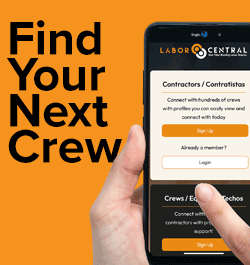Jim Hanson - Test Drive a Mini Macaden Today! - PODCAST TRANSCRIPTION
June 24, 2023 at 8:00 a.m.Editor's note: The following is the transcript of a live interview with Jim Hanson of SOPREMA. You can read the interview below or listen to the podcast.
Intro/Outro: Welcome to Roofing Road Trips with Heidi. Explore the roofing industry through the eyes of a long-term professional within the trade. Listen for insights, interviews, and exciting news in the roofing industry today.
Heidi J. Ellsworth: Hello and welcome to another Roofing Road Trips from Roofers Coffee Shop. My name is Heidi Ellsworth and we are here today to talk about something that I think is really cool. It's really, in a way, the first robots of the roofing industry, if you want to say that. It's really a machine, but the MINI-MACADEN has just been changing the industry and I'm here with Jim Hanson, business development at SOPREMA to talk about it. Jim, welcome to the show.
Jim Hanson: Well thank you Heidi, and thank you for inviting me and good morning to people on the West Coast and good afternoon to the people on the East Coast.
Heidi J. Ellsworth: There you go, we cover the country. Before we dive into this, because I love the MINI-MACADEN and you have a lot going on with the rental program, but before we do that, if you could introduce yourself, tell us a little bit about you and SOPREMA.
Jim Hanson: Sure. My name's Jim Hanson. I am the Business Development Manager with SOPREMA. Started with SOPREMA back in January of 2021. Prior to that, I've been with several other companies, as well with my own business, for the past 30 or 35 years in our lovely industry of the commercial roofing and waterproofing industry.
Heidi J. Ellsworth: We love it. We love it. And no one ever leaves, so that's kind of nice. We all know each other for a long time.
Jim Hanson: Yeah, we get recycled through a lot. But it's a learning experience. If someone says there's no career path in this industry, they're talking to the wrong people.
Heidi J. Ellsworth: Yeah. Oh.
Jim Hanson: That's all I have to say. You have great opportunities in this industry.
Heidi J. Ellsworth: So true. The industry is changing. I mean, we know we have labor shortages, we know we are looking for more skilled installers, but also, we need to supplement with the right machinery. And as I said earlier, I realize it's not a robot, but the machinery is making such a difference. And so let's talk a little bit about the MINI-MACADEN. If you could tell everybody what that is, the little bit of the history and why is it so popular?
Jim Hanson: Great question, and you know what, I'd be remiss if I don't answer the second part of your first question about SOPREMA. SOPREMA is a waterproofing, roofing, building envelope manufacturer established in 1909, privately-owned, family-owned business with close to 90 locations across this globe. I couldn't tell you how many employees we have, but we make up the SOPREMA Group, which is the Performance Roof Systems, Chem Link, TRP, Furbish and RESISTO and more to be announced somewhere in the future, I'm sure. So great company to work for great people. Our CEO Tim Kersey, I couldn't ask for a better leader and the opportunities he presents to all of us to try to get ahead in this industry has been wonderful. It's been a great experience working for them.
Now, to answer your second question about the MINI-MACADEN. Yes, the MINI-MACADEN is just an awesome, awesome machine. The owner of SOPREMA in Denis who's based out of Canada back in the early 2000s, got together, from what I understand, this is kind of the backstory, and started brainstorming and Denis said that he can make a machine to mechanize the installation process of both the base sheet and the cap sheet when you're using torching. He said he could develop a machine that would just revolutionize the industry and boy has it.
Yeah, the MINI-MACADEN first rolled out in 2006. It's big brother, the MACADEN, I'm not sure when it was launched, but both of them combined, it is just amazing what they've been able to do in the respective industries, whether it's in the civil industry or the commercial roofing and waterproof industry. The MINI-MACADEN basically takes the process of hand torching, which is a tedious process and a time-consuming process to hand weld or hand torch your base sheet or your cap sheet, and eliminates a number of steps in that process while expediting the production and the efficiency of the installation of the membrane to a point where it is done in such manner that it's almost a near perfect installation.
Heidi J. Ellsworth: Wow.
Jim Hanson: Yeah, it is just fabulous. When you see these machines in action, you just... I've been on rooftops with contractors who said, "Yeah, I'd like to try one." I'll bring one out, and he looks at it or the owners look at it and they're like, "You got to be kidding me. I can't believe what I'm seeing here." When you can take a roll of membrane and you don't have to unroll it and relax it, you just load it into the MINI-MACADEN, you turn on the heat source, you turn on the power source, which engages the drive train, and this machine is capable of then putting down one membrane roll, which is basically approximately one square every minute and a half, and it's a near perfect installation. It takes about 30 to 45 seconds to reload the machine with the new roll, and then it's back in business. And what we're seeing with the MINI-MACADEN is a production level that's five rolls every 15 minutes to one roll hand torching.
Heidi J. Ellsworth: Wow, that's amazing. Wow.
Jim Hanson: It's truly, truly amazing. And the top of the productivity, the other benefits to the MINI-MACADEN, we're not using open flame. It's hot air. It's 1600 degrees of hot air being blasted through a one-inch plenum on the back of the membrane roll melting and creating a cascade of asphalt on the back of that sheet that is then laid down in its own asphalt and then lightly pressure rolled into place, and it's welding it. It's not only hot air welding the field of that membrane, but also the side lap, and it creates the perfect lead out edges on both sides of the membrane. And again, you don't see this when your hand torching. You can't get this level of quality when your hand torching.
Heidi J. Ellsworth: No.
Jim Hanson: You can tell I'm excited about it. It's a great machine.
Heidi J. Ellsworth: I'm excited about it too. I saw it in action at K Post down in Dallas, Texas, and I was so impressed with the installation, how it works, and really the labor savings. I mean, let's talk about that because installers are actually loading the machine and working that way. They're working different.
Jim Hanson: Yes, they are. The MINI-MACADEN helps the contractor deal with a couple issues that you brought it up as far as the labor shortages in our industry. Crew sizes up on the rooftop have dwindled. You no longer see a crew of 12 or 15. They're having to do more with less or keep that same level of production they were doing 10 or 15 years ago with less labor up on the rooftop, less bodies. The technologies really coming into play. We see this with the force multiplier fact. Take a look at a crane versus hand loading. Okay, yeah, crane's expensive, but you can get a lot more loaded on the roof than trying to hand load it. You look at fastening machines that dispense the plates and the screws, whereas in back in the 70s and 80s and 90s, the mechanics were bending over, putting down a four cent plate and driving a screw through and think about the back problems those individuals have now because of that.
And then you look at air nailers versus hand nailing. There's all these little innovations that have come into our industry that have really changed the mode of production as well as the safety for the users, as well as the fatigue factor. It's lowering the fatigue factor for the... So they can maintain the same level of production at that first hour, eight o'clock in the morning throughout the course of the day until quitting time. We're not beating up our mechanics the way we used to with all the physical labor they used to do.
So the MINI-MACADEN itself, from a labor savings aspect, we could take say a crew of eight, say for example, they're laying out the insulation, the cover board or substrate board, and then they need to torch down a base sheet kind of rule thumb estimating wise is about eight to nine squares per mechanic per day. So if it's a crew of eight, you're looking at about 64 hours complete. Well double, if not triple that with the MINI-MACADEN. So what that does from a install cost, we're able to lower the install cost. On average, we see swings from $30 a square up to on a job I was looking at this morning that I priced out for rental machines, the savings per square was $110 a square.
Heidi J. Ellsworth: That's amazing.
Jim Hanson: Our install cost is now coming down to that of what everybody thought was the most economical system installed, which is a TPO system. Our installation rate is neck and neck, so it's... And on top of it, we're talking about a multi-layered waterproofing system with all that redundancy built into it versus say a 60 ml TPO, which if it has a hole in it, it's leaking, whereas you puncture a cap sheet on a mod bit, you still have the base sheet. There's a lot of benefits, and now we're showing that yeah, we can install these multi-layered systems at a far more efficient rate to lower the install cost to that of that single ply, no redundancy built in membrane system.
Heidi J. Ellsworth: Well, and I love when you look at that bringing down installation costs, that helps the contractor, that helps the building owner. And I have to go back on the fatigue level too of the installers because not only do you have the machine and safe wise, the weight, but you also have the smaller rolls, right? So they're not lifting as bigger rolls and everything out there. So hopefully that's right, but I mean, it seems like it all comes together
Jim Hanson: On the roll size we really didn't have to change our role lengths. Actually we're looking at where can we increase the length of the roll so we can cut down on the amount of end laps that have to be welded.
Heidi J. Ellsworth: Okay.
Jim Hanson: But no, a typical say base sheet, depending on the thickness of the sheet itself can weigh anywhere from 70, 80 pounds out up to a hundred pounds. The cap sheet usually 90 to 120, 130 pounds. So the weight factor is still there, but what's nice about it, say take a three person team, one person to run the machine and make sure it's tracking true for the base sheet installation. You have another mechanic following with him, making sure all the roles are staged. So when they get to the end of the roll, it's just a simple tip over and lay it in the machine. And then you have the third mechanic who when they get to the end of the roll and they start up the next one, that mechanic jumps in there and does the end laps. So it's just a seamless flow of production.
And again, the fatigue factor is not there. These production numbers, I was on a job three weeks ago down in the Arizona, and I was timing the production. How long does it take to do a roll? I'm like, you know what? My numbers are not accurate. So I set the stopwatch and I said, "I'm going to time an hour." See how many rolls we get done. On this particular job, they had three machines, so it was a pretty good sized project, and each machine hour after hour after hour after hour with a crew, three on each machine, we're putting down anywhere from 22 to 24 rolls or 22 to 24 squares per hour of a near perfect installation.
Heidi J. Ellsworth: Wow.
Jim Hanson: And those are numbers, and you take that production and what I was seeing, say nine o'clock through 11 o'clock did not drop that afternoon after lunch. They came in and they fired up the machines and they continued with that same high level of productivity, no fatigue factors. Talking with the mechanics and the operator, just getting to know them and seeing what their thoughts were. 20 years ago, they would have said, "We don't like it because it's taken away from jobs." On the contrary, the younger mechanics coming into this industry are very tech savvy and they want to use this type of equipment. They gravitate to it and they appreciate the fact that they can go home at the end of the day and they can pick up the kids, hug the wife, go out with the guys, play some sports. They're not beat up, they're still able to go home with some energy, enjoy the rest of the day and come back to work, not regretting it the next morning.
Heidi J. Ellsworth: So really, it can even be a recruitment, part of recruiting for a roofing company. I mean, when you think about it, they should be talking about these MINI-MACADENs that they're using and how the new technologies and how that's really taking care of the installation crews.
Jim Hanson: No, agreed. I think most of the equipment that's out there that's available to the contractor, if they would promote it more, say, well, I'm a big believer in fastening systems. I still cringe when I go up on a rooftop and I see people in their twenties, thirties and forties still bending over, dropping a plate and a screw. It just blows my mind. I started in this industry selling the SFS Isofast back in the mid-80s. Automated fastening system. When the regional manager at the time was showing me how this worked at the CRCA show, I was working the booth there. I said, "Wow, this is a great machine. I love it". And I was just, the juices were flowing. And I said, well, tell me how do they do it otherwise? And he handed me a handful of plates and screws and a screw run. He said, bend over and start putting them in. I'm like-
Heidi J. Ellsworth: Oh my gosh.
Jim Hanson: I'm like, okay, I'm right out of college. I'm thinking this does not make sense. Contractors I think are starting to embrace a higher level of technology to help address labor shortage we're dealing with, but also to help with the retainage of their employees. I think that's another big concern. You don't want your mechanics to burn out and find right a career elsewhere. You want to keep them there and help them move up through the ranks, and eventually, maybe they take over the company 20 years down the road, but we have to keep working together in this industry to find ways to help mechanize the installation process to a point where it just helps the installers do more without burning them out at the end of the day and the end of the week.
Heidi J. Ellsworth: So smart. I mean, that's exactly what we need to be doing and keeping everyone longer. That retention factor is so important. And in fact, okay, so there is one thing I've been hearing you say. I've been hearing it from SOPREME. You call the MINI-MACADEN a true force multiplier. Tell me what that's about, because I love that.`
Jim Hanson: The force multiplier is something that I was using back with the SFS Isofast system. I can take one machine and do the work of four. Okay. No different than a crane can do the work of many. You still have your crew, but you're able to help them accomplish more in the day. So just that single device, that single piece of equipment that allows your crew the opportunity to gain a higher level productivity than they would achieve without it. Okay. A GPS is a good example. You give someone a GPS, they can get from point A to point B with no problem.. Give them a map, different story
Heidi J. Ellsworth: Takes a little bit longer takes.
Jim Hanson: And if they don't have a GPS or a map, they're kind of lost. So there's your force multiplier just in baby steps that how you're able to provide a level of efficiency that they could not otherwise achieve without that equipment. So it's a good hook every time I promote the MINI-MACADEN, a true force multiplier, and it definitely is. Once you see this machine in action, and I've had some contractors at the IRE show come up and they're shaking their head and disbelief, and I said, "Listen, the facts speak for themselves," and I point to the monitor over my shoulder and it's a split screen of a MINI-MACADEN being used with the same crew that's hand torching below it, and it's a time stamp. And I was like, so you're telling me that your crew's no different than these guys unrolling the membrane?
So right there, we're already at a four or five minute headstart so you don't have to unroll the membrane and let it relax. And then I don't have a guy swinging a torch back and forth. Now, here's the other thing about the process that the MINI-MACADEN achieves. When you're hand torching, you're applying heat at one end of the roll on the backside of the roll, and then you're going across to the other. You're going left to right, and you're trying to melt that asphalt backing. Okay. So I have intense heat on one side, and I go over to the other side and I have intense heat there where I started that heat level's dropped down. I'm not getting consistent heat across the entire back of this roll.
Heidi J. Ellsworth: Yeah, that makes so much sense.
Jim Hanson: Yeah, MINI-MACADEN and not that way. It's 1600 degrees of forced hot air. Wow. That's coming out. Like I said, that one inch plenum, that's about 40 inches long, two inches or three inches from the back of that membrane roll, and it's just melting that asphalt consistently. And as that asphalt's melting and making contact with the roof substrate, the membranes didn't laid into it under somewhat of a tension. So it's being laid in really nice and tight. And then there's a pressure roller, kind of like what the heat welders use when they're welding single ply, that red silicone pressure wheel right on the seam. We have a 40-inch wide roller like that, applying pressure across the entire sheet and embedding it in its own asphalt and eliminating any possibility for blisters or voids.
Heidi J. Ellsworth: I love it. Yeah.
Jim Hanson: Wow. It's just phenomenal. So kudos to the developer Denis. He did a great job, really thought this thing through. We're on our third generation of this machine, and it really hasn't changed that much since 2006, except for some updates and a couple pieces of the equipment used within the MINI-MACADEN as well as the software program. Now we can track hours, we can track how many feet are going through the machine, and it's also laser guided. So when we're doing our cap sheet, our SOPREMA cap sheet installation, it can be set up to run automatic using the laser technology we have on it.
Heidi J. Ellsworth: Wow. That's awesome.
Jim Hanson: So at the end of the day, what they can do when they're installing our cap sheet, they can set the machine up, they being the roof mechanic, can set it up to where not only will it track straight down that salvage edge with the laser technology, but the machine will actually stop on its own when it gets to the end of the membrane. It'll stop the heat source and then it will go a little bit further, and then the machine will shut down, and then you can reload the machine with the next roll of cap sheet. And this way you get a consistent overlap of six, eight or 12 inches, whatever specified. So we can dial in the exact overlap or end lap overlap with the MINI-MACADEN, and so there's not much you can't do.
Heidi J. Ellsworth: So I wasn't too far off on my robot comment.
Jim Hanson: No, you, you definitely weren't. Yeah, it's-
Heidi J. Ellsworth: Wow.
Jim Hanson: And it also comes with the headlight in case you have to work early in the morning or late at night.
Heidi J. Ellsworth: Which summer's coming and down south they're going to need that. One of the things I love, and I've been seeing this lately a lot, is the data that comes back out of the machine, that software that enables the data to get back to that contractor, the roofing owner, to really be able to see how things are going on the job, whether that's they share that with their building owners or their consultants or whatever. But that kind of data is becoming increasingly demanded. I mean, I think it's something we're going to see down the road.
Jim Hanson: Yes. There's a company I work with closely, which is Graco, the spray equipment manufacturer. I actually had the opportunity to become a master CT certified technician for them through a lot of hours of online training as well as a week or two of hands-on training and the technology they use with the blue link, which allows you with your cell phone to basically look up your particular spray rig and find out how many gallons went through it that day and how long it was running. So yes, I think the technology is there that's going to allow us to do even more with the MINI-MACADEN. And so say a sales rep needs to provide a daily report, or the field inspector needs to provide a daily report, he doesn't necessarily have to be on site. He can just log in and key up Bluetooth connect and link to the MINI-MACADEN and say, "Okay, how many rolls did we install today?"
He doesn't have to call a supervisor who might not be available on phone. He can say, "Okay, we did wow, 160 rolls today. We're a little bit short, but that's still not bad production. And the machine ran for seven hours." And then they can look at us, okay, we have to have a service at say, 200 hours. How many hours do we have into it? And they can look that up. So yeah, we're looking down the road at that technology and we're also looking at a couple other pieces of equipment that will enhance the productivity of the MACADEN to the next level.
When it comes to moving the MINI-MACADEN, for example, once you get down to the end of the run, you have to go all the way back to the beginning. It's a 661 pound machine. It rolls pretty easily, but you have to tilt the machine back with the bars that are provided and kind of roll it on two wheels like you're skateboarding. We have a new piece of equipment that we'll be bringing out that it's basically a dolly system. You just drop the nose of the MINI-MACADEN in the dolly, and you can push it easily across the rooftop.
Heidi J. Ellsworth: That's great.
Jim Hanson: Yeah. So again, we're looking at what can we do to lessen the fatigue factor of the operator of the MINI-MACADEN?
Heidi J. Ellsworth: Yeah, that is so cool. I know a lot of contractors who own MINI-MACADENs, but you have started a great rental program for MINI-MACADENs. Can you tell us about that? Because I mean, the name of our podcast, Jim, is Test Drive a MINI-MACADEN Today, and you're going to let them do that. So how's that working?
Jim Hanson: The response at first, last year when I took this opportunity to become the business development manager and take over this program, the response of me saying, "We're going to discontinue the sales in the MINI-MACADEN and we're going to go to a rental program," well, it received a lukewarm response at best. But then when I started providing the facts and figures about what we've accomplished with the MINI-MACADEN since we've been sold into the United States starting in 2014 and where they're being used and who's actually buying them, it started to make a lot more sense to those people that might have been on the fence about the rental program. Since then, the response has been overwhelming. We have a fleet of, I think, eight rental units and the number of projects we have lined up to rent these MINI-MACADENs from now until right now, we have machines rented out until sometime next year.
Heidi J. Ellsworth: Oh my gosh.
Jim Hanson: It doesn't mean that all eight will be rented out. It's we have projects that are extending out that far that will be renting the MINI-MACADENs, and the program is enhanced. The rental program's enhanced to a point where one of the reasons why I decided to do the rental program or go with the rental program after having conversations with my director and CEO is that right now the only contractors that were able to afford the MINI-MACADEN were the very large contractors, but the questions I was fielding at the IRE shows and the CRCA shows and other conventions is, "Man, I would really like to use this MINI-MACADEN. I have this job coming up." And the problem was the expense of the MINI-MACADEN. The contractor could not justify the expense of purchasing one with the idea that, okay, I have this one big job and then it's going to sit in my warehouse for another year or two before I use it again.
So my thought process, my goal was how do I make this affordable to all contractors on a job per job basis, which helps us, SOPREMA, sell more rolls, sell SOPREMA Group rolls, but it also helps us because we're getting a higher quality installation of our product. So think of what it does for us as a company where we're looking at warranties that are 15, 20, 25 years. We want the best installation possible of our membrane because we're the ones that are carrying that asset more or less under a warranty. So I look at it as if I'm going to warrant a project long term and I can either have it hand torch, nothing against hand torching, or I can have it done with the MINI-MACADEN as a building owner, I'm going to say, "Give me the MINI-MACADEN." I don't have open flame, and I'm getting a far superior installation with the machine, production aside.
Heidi J. Ellsworth: Yeah, it's a great solution. I mean, there's just no question. So how do contractors rent them then? What's the process?
Jim Hanson: So what we do is I put together a few pieces of information for the contractor. They can either send an email to MINI-MACADEN.SOPREMA.us and saying, "I'm interested. What is the process?" My response at that point is I'll send them a brochure. On the brochure, the MINI-MACADEN brochure, it's a four-page brochure, is a QR code. On that QR code, there's a link to the actual time study video, so they can see the side by side comparison on a split screen. I provide them with a demo time study form showing what the return on the labor savings are when you rent the MINI-MACADEN. And I think there was another piece of information there, maybe our FAQ sheets that's attached. So there's a lot of information attached there. And then what I do is I actually contact the individual and I ask some additional information.
Okay, crew size, how many rolls are you looking to install? How many base sheet versus cap sheet? Are you doing a tear off or is it a layup? Tell me a little bit more about the job. What is the billable rate? You go down south, it's 65, you go out west, it might be 80, you go up to New York, 80 to $125. This is not top secret stuff, but in order to really see the true benefits of the MINI-MACADEN, I have to understand what the billable rate is to have a mechanic up on the rooftop. I take that information in, and then now what happens on this formula I created with the help of some of the people in our office, is I can take and figure out what the daily labor rate is for that project. Then I have another formula that tells me, okay, based on that crew size, if they're hand torching, they're going to get X amount of squares.
If they use the MINI-MACADEN, they're going to double, if not triple that production. And then that carries over and it shows the labor difference between hand torching versus using the MINI-MACADEN. And then it shows that difference as your labor savings. And then it deducts the rental fees. We have a cleaning fee that we build into the rental fee. We have a training cost, which is a one-time training cost for the crew, meaning that if I train them on one job and it's the same crew on the next job that they rent the machine, they don't have to pay for that training. And then there's the freight cost to get the machine to the job and then back to Wadsworth. So all those fees are taken in consideration and are subtracted from the difference in labor savings, and it gives you your net potential labor savings. And when you see a labor savings, they've been $20,000 for smaller projects. A job I was looking at this morning, it was almost three quarters of a million dollars.
Heidi J. Ellsworth: Oh, holy cow. Wow. Yeah. Big difference.
Jim Hanson: Big difference. But again, that's a very large job. That's multiple layers, and that's over a very long process. There is a reason why contractors who bought these machines starting back in 2006 through last year, 2022, still have them and still have them working. It's because they make money for the company day in and day out. They might still bid the job, the hand torch, but then they bring the MINI-MACADEN out and they increase your bottom line.
Heidi J. Ellsworth: Well, thank you. I have to say, a lot of this information also is on your directory, on Roofers Coffee Shop, along with all of the links to get to your website to start that process. You guys better get ready. I think you're going to have to buy some more of those.
Jim Hanson: Already in the pipeline.
Heidi J. Ellsworth: Already in the pipeline. I love it.
Jim Hanson: Already got that covered.
Heidi J. Ellsworth: I love it. Well, Jim, this is the future. Thank you so much for sharing with us today.
Jim Hanson: Anytime, Heidi, I appreciate the opportunity. Enjoy the show and look forward to hearing from you in the future.
Heidi J. Ellsworth: Yeah, I'm thinking we may have you back again and we can talk about more machines out there that are changing the industry. I think it's very interesting.
Jim Hanson: We've got a couple that I'm working on, so yes, I look forward to those conversations.
Heidi J. Ellsworth: We'll have you back. Thank you so much.
Jim Hanson: Thanks. Have a great day.
Heidi J. Ellsworth: You too. And thank you everybody for listening today. This is the stuff, man, I love this. I love about the tools, the machines, the things that are changing the industry. So continue to listen to all of our roofing road trips to find out all this great information. You can find all this information, a lot of it on the directory for SOPREMA, so be sure to check that out along with all of their articles and everything that SOPREMA's doing. They're doing some amazing progressive sustainability. You name it, there's a lot of great stuff out there. Also, be sure not to miss a single episode of Roofing Road Trips. Check out the RLW navigation. Under there you'll find podcasts and roofing road trips, or on your favorite podcast channel, be sure to subscribe and set those notifications. We don't want you to miss a single episode, and we will be seeing you next time on Roofing Road Trips.
Intro/Outro: Make sure to subscribe to our channel and leave a review. Thanks for listening. This has been Roofing Road Trips with Heidi from the RoofersCoffeeShop.com.
Recommended For You

Tom Biller - Labor Shortage and the Importance of Training - PODCAST TRANSCRIPTION
Read More ...
Susan Eccles - Drone Legalities for Roofing Companies - PODCAST TRANSCRIPTION
Read More ...
Chris Arrington, Kristen Harford & Bret Foster - Inside the 2025 NTRCA Tradeshow - PODCAST TRANSCRIPT
Read More ...


















Comments
Leave a Reply
Have an account? Login to leave a comment!
Sign In